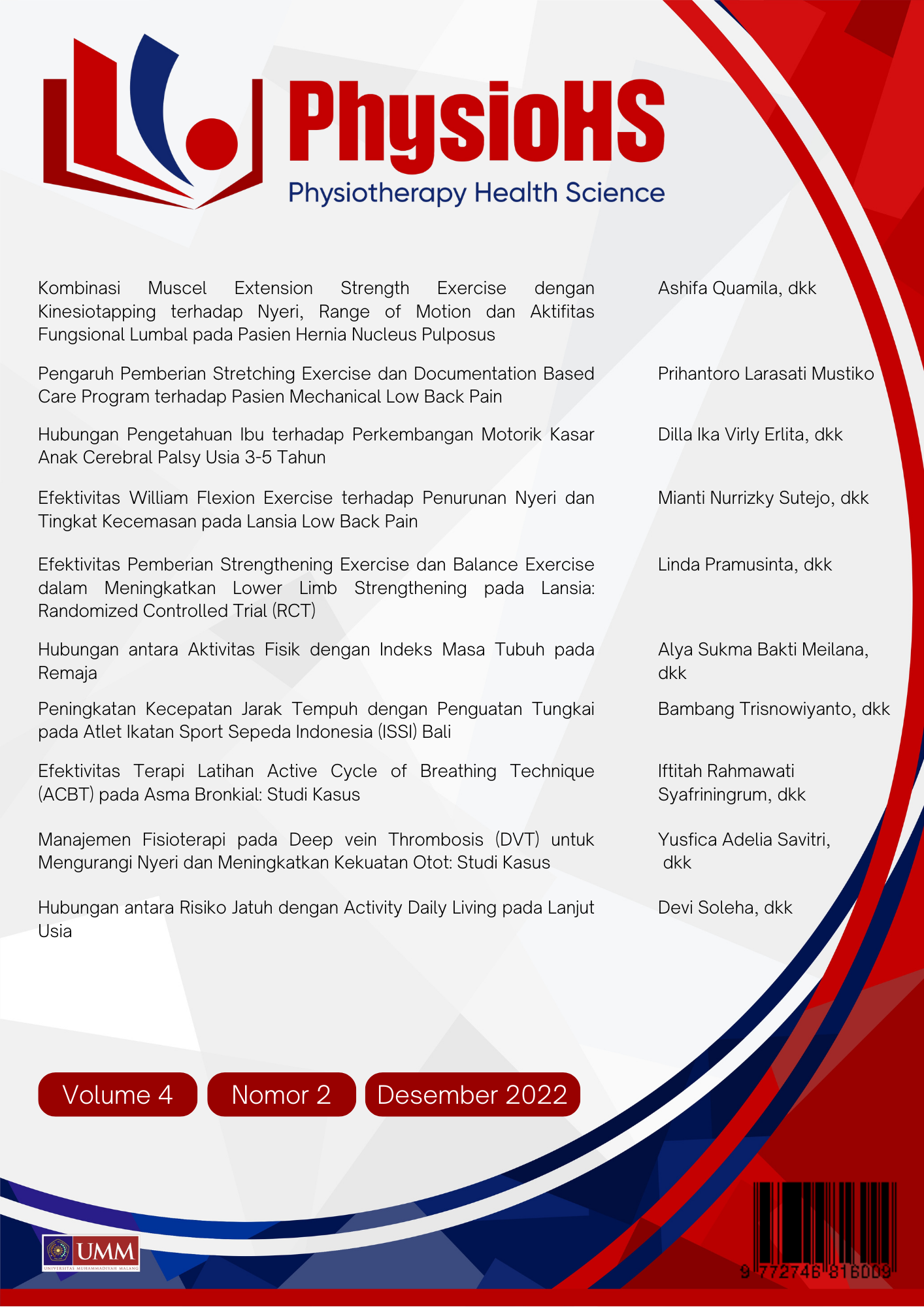Hubungan antara Risiko Jatuh dengan Activity Daily Living pada Lanjut Usia
DOI:
https://doi.org/10.22219/physiohs.v4i2.23080Keywords:
activity daily living, indeks katz, morse fall scale, risiko jatuhAbstract
Activity of Daily Living (ADL) adalah aktivitas sehari-hari yang berisi kemandirian seseorang dalam melakukan aktivitas dan fungsi kehidupan sehari-hari yang teratur. Penelitian ini untuk membuktikan adanya hubungan antara risiko jatuh dengan ADL pada lanjut usia secara deskriptif kuantitatif dengan desain cross-sectional. Sampel dipilih menggunakan teknik purposive sampling di Panti Werdha Wisma Mulia, Jakarta Barat. Total sampel sebanyak 30 lansia dan pada tiap sampel diperoleh data risiko jatuh yang diukur dengan Morse Fall Scale (MFS) dan ADL yang diukur dengan Indeks Katz. Jenis kelamin paling banyak pada sampel adalah perempuan (66,7%) dengan usia rata-rata sebesar 77 tahun. Selanjutnya nilai mean±SD pada pengukuran risiko jatuh diperoleh sebesar 40,67±18,83 dan nilai ADL sebesar 3,77±1,612. Uji hipotesis dengan uji Fisher menunjukkan terdapat hubungan yang signifikan antara risiko jatuh dengan ADL pada lansia (p=0,007) yang mana pada risiko jatuh dan ADL. Sehingga terdapat hubungan signifikan antara risiko jatuh dengan ADL pada lanjut usia.
Downloads
References
Amiria, C. P., & Abikusno, N. (2016). Hubungan Tingkat Kemandirian Dengan Resiko Jatuh Pada Lansia. e-Print 3(16), 89–98.
Arli, S. K., Yildiz, M., & Bakan, A. B. (2020). Relationship between fall risks and activities of daily living in older individuals. Frontiers of Nursing, 7(3), 249–256. https://doi.org/10.2478/fon-2020-0022
Cuevas-Trisan, R. (2017). Balance Problems and Fall Risks in the Elderly. Physical Medicine and Rehabilitation Clinics of North America, 28(4), 727–737. https://doi.org/10.1016/j.pmr.2017.06.006
Ikhsan, I., Wirahmi, N., & Slamet, S. (2020). Hubungan Aktifitas Fisik Dengan Risiko Jatuh Pada Lansia Di Wilayah Kerja Puskesmas Nusa Indah Kota Bengkulu. Journal of Nursing and Public Health, 8(1), 48–53. https://doi.org/10.37676/jnph.v8i1.1006
Khow, K. S. F., & Visvanathan, R. (2017). Falls in the Aging Population. Clinics in Geriatric Medicine, 33(3), 357–368. https://doi.org/10.1016/j.cger.2017.03.002
PERMENKES. (2015). Peraturan Menteri Kesehatan Republik Indonesia Nomor 65 Tahun 2015 Tentang Standar Pelayanan Fisioterapi. In 2015 (Vol. 151, pp. 10–17). https://doi.org/10.1145/3132847.3132886
Prastowo, B., & Windayati, A. M. (2021). The Role Of Elderly Sexuality On Musculoskeletal Disorders (MSDs): Bibliometric Studies. Physiotherapy and Physical Rehabilitation Journal 1(1), 1–9.
Resnick, B., & Boltz, M. (2019). Optimizing Function and Physical Activity in Hospitalized Older Adults to Prevent Functional Decline and Falls. Clinics in Geriatric Medicine, 35(2), 237–251. https://doi.org/10.1016/j.cger.2019.01.003
RIKESDES. (2019). Kementerian Kesehatan Republik Indonesia. In Kementerian Kesehatan RI 1(1).
Ritonga, N. L. (2018). Tingkat Kemandirian Lansia dalam Pemenuhan ADL (Activity of Daily Living) dengan Metode Katz di Posyandu Lansia Kelurahan Tegal Sari III Medan Area. Jurnal Ilmiah Kesehatan 44–48.
Rugbeer, N., Ramklass, S., Mckune, A., & van Heerden, J. (2017). The effect of group exercise frequency on health related quality of life in institutionalized elderly. Pan African Medical Journal, 26, 1–14. https://doi.org/10.11604/pamj.2017.26.35.10518
Tyagi, S., Perera, S., & Brach, J. S. (2017). Balance and Mobility in Community-Dwelling Older Adults: Effect of Daytime Sleepiness. Journal of the American Geriatrics Society, 65(5), 1019–1025. https://doi.org/10.1111/jgs.14735
Wang, D. X. M., Yao, J., Zirek, Y., Reijnierse, E. M., & Maier, A. B. (2020). Muscle mass, strength, and physical performance predicting activities of daily living: a meta-analysis. Journal of Cachexia, Sarcopenia and Muscle, 11(1), 3–25. https://doi.org/10.1002/jcsm.12502
Downloads
Published
How to Cite
Issue
Section
License
Copyright (c) 2022 muthiah munawwarah

This work is licensed under a Creative Commons Attribution-ShareAlike 4.0 International License.
Authors who publish with Physiotherapy Health Science (PhysioHS) agree to the following terms:
- For all articles published in Physiotherapy Health Science (PhysioHS), copyright is retained by the authors. Authors give permission to the publisher to announce the work with conditions. When the manuscript is accepted for publication, the authors agree to automatic transfer of the publishing right to the publisher.
- Authors retain copyright and grant the journal right of first publication with the work simultaneously licensed under a Creative Commons Attribution-ShareAlike 4.0 International License that allows others to share the work with an acknowledgement of the work's authorship and initial publication in this journal.
- Authors are able to enter into separate, additional contractual arrangements for the non-exclusive distribution of the journal's published version of the work (e.g., post it to an institutional repository or publish it in a book), with an acknowledgement of its initial publication in this journal.
- Authors are permitted and encouraged to post their work online (e.g., in institutional repositories or on their website) prior to and during the submission process, as it can lead to productive exchanges, as well as earlier and greater citation of published work (See The Effect of Open Access).
This work is licensed under a Creative Commons Attribution-ShareAlike 4.0 International License.





















